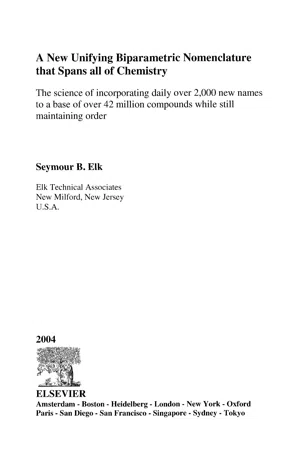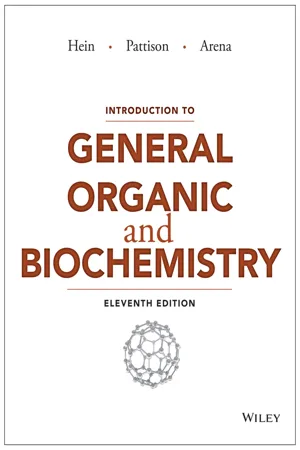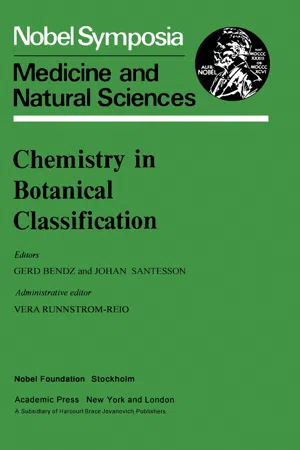Chemistry
Classification and Nomenclature
Classification and nomenclature in chemistry refer to the systematic organization and naming of chemical compounds based on their properties and structures. Classification involves grouping substances into categories based on common characteristics, while nomenclature focuses on assigning specific names to these substances according to established rules and conventions. These processes are essential for clear communication and understanding within the field of chemistry.
Written by Perlego with AI-assistance
Related key terms
1 of 5
8 Key excerpts on "Classification and Nomenclature"
- eBook - PDF
A New Unifying Biparametric Nomenclature that Spans all of Chemistry
The science of incorporating daily over 2,000 new names to a base of over 42 million compounds while still maintaining order
- Seymour B. Elk(Author)
- 2004(Publication Date)
- Elsevier Science(Publisher)
Chapter 1 Introduction CHAPTER ABSTRACT: Chemical nomenclature today lacks uniformity! In each of the historically evolved subdivisions of chemistry there are different, unrelated algorithms, which assign names to molecules, ions, and monomers. These protocols are not only independent of one another, they are, also, often incompatible. A unified system of nomenclature, which spans these subdivisions, is needed in order to be able to maintain consistency in naming diverse compositions of matter. The historical evolution of these separate, uncoordinated systems of taxonomy and nomenclature, along with the rapid growth in both the number and the variety of new chemicals that fail to fit neatly into one of these domains, has made research much more difficult. In order to remedy this situation, a re-examination and clarification of many of the terms used to describe chemical structure has been undertaken. This produces an expanded world-view that emphasizes the three dimensionality of chemical moieties, with special attention to the mathematical foundations that underlie all of chemical structure. Diverse historical perspectives that have, at times, stressed these differences, while masking the similarities among chemical has produced mutually exclusive subsets of chemistry. In place of this historical mindset comes a new perspective on the place of nomenclature in chemical thought. No longer is it just a necessary evil in order to be able to distinguish one chemical from another for indexing and cataloging. Instead, when closely examined, the consistency that has to be built into a system that has the capacity to describe, as well as to differentiate between, similar chemicals often suggests new lines of research to pursue, as well as novel formulations of matter that have not yet been discovered. - Morris Hein, Scott Pattison, Susan Arena, Leo R. Best(Authors)
- 2014(Publication Date)
- Wiley(Publisher)
© Exactostock/SuperStock A s children, we begin to communicate with other people in our lives by learning the names of objects around us. As we continue to develop, we learn to speak and use language to complete a wide variety of tasks. As we enter school, we begin to learn of other languages—the lan- guages of mathematics, of other cultures, of computers. In each case, we begin by learning the names of the building blocks and then proceed to more abstract concepts. Chemistry has a language all its own—a whole new way of describing the objects so familiar to us in our daily lives. Once we learn the language, we can begin to understand the macroscopic and microscopic world of chemistry. 6.1 Common and Systematic Names 6.2 Elements and Ions 6.3 Writing Formulas from Names of Ionic Compounds 6.4 Naming Binary Compounds 6.5 Naming Compounds Containing Polyatomic Ions 6.6 Acids NOMENCLATURE OF INORGANIC COMPOUNDS C H A P T E R 6 This seashell is formed from the chemical calcium carbonate, commonly called limestone. It is the same chemical used in many calcium supplements for our diets. C H A P T E R O U T L I N E 6.1 • Common and Systematic Names 99 6.1 COMMON AND SYSTEMATIC NAMES Distinguish between the common and systematic names of chemical substances. Chemical nomenclature is the system of names that chemists use to identify compounds. When a new substance is formulated, it must be named in order to distinguish it from all other sub- stances (see Figure 6.1). In this chapter, we will restrict our discussion to the nomenclature of inorganic compounds—compounds that do not generally contain carbon. LEARNING OBJECTIVE Common names are arbitrary names that are not based on the chemical composition of compounds. Before chemistry was systematized, a substance was given a name that generally associated it with one of its outstanding physical or chemical properties.- eBook - ePub
Chemical Graph Theory
Introduction and Fundamentals
- D Bonchev(Author)
- 2018(Publication Date)
- CRC Press(Publisher)
These methods include nomenclatures, notations, connection tables, adjacency matrices, molecular formulas, and fragment codes [ 1, 2 ]. The term “nomenclature” is sometimes used as a generic term to include not only nomenclatures but also notations and connection tables. Since reference is made in this chapter to nomenclatures and notations, it is useful to define them here and to distinguish them from connection tables (see Figure 1). Nomenclature is defined [ 3 a] as: “a system or set of names or designations used in a particular science, discipline, or art and formally adopted or sanctioned by the usage of its practitioners.” Chemical nomenclature is more specifically defined as: “a set of chemical names that may be systematic … or not and that aims to tell the composition and often the structure of a given compound by naming the elements, groups, radicals, or ions present and employing suffixes denoting function …, prefixes denoting composition …, configuration prefixes …, operational prefixes …, arabic numbers or Greek letters for indicating structure (as positions of substituents), or Roman numerals for indicating oxidation state.” Chemical nomenclature is illustrated in Figure 1 with reference to the chemical structure diagram mentioned above - eBook - PDF
- Morris Hein, Susan Arena, Cary Willard(Authors)
- 2016(Publication Date)
- Wiley(Publisher)
A s children, we begin to communicate with other people in our lives by learning the names of ob- jects around us. As we continue to develop, we learn to speak and use language to complete a wide vari- ety of tasks. As we enter school, we begin to learn of other languages—the languages of mathematics, of other cul- tures, of computers. In each case, we begin by learning the names of the building blocks and then proceed to more abstract concepts. Chemistry has a language all its own—a whole new way of describing the objects so familiar to us in our daily lives. For example, the seashell shown above is formed from the chemical calcium carbonate, commonly called limestone. It is the same chemical used in many calcium supple- ments for our diets. Once we learn the language, we can begin to understand the macroscopic and microscopic world of chemistry. © Exactostock /SuperStock Nomenclature of Inorganic Compounds C H A P T E R O U T L I N E 6.1 Common and Systematic Names 6.2 Elements and Ions 6.3 Writing Formulas from Names of Ionic Compounds 6.4 Naming Binary Compounds 6.5 Naming Compounds Containing Polyatomic Ions 6.6 Acids 6 6.2 • Elements and Ions 103 6.1 Common and Systematic Names Distinguish between the common and systematic names of chemical substances. Chemical nomenclature is the system of names that chemists use to identify compounds. When a new substance is formulated, it must be named in order to distinguish it from all other substances (FIGURE 6.1). In this chapter, we will restrict our discussion to the nomenclature of inorganic compounds—compounds that do not generally contain carbon. 3 or more Polyatomic compounds See Section 6.5 2 Binary compounds See Section 6.4 1 Element See Sections 3.1–3.4 Number of Elements Present FIGURE 6.1 Where to find rules for naming inorganic substances in this book. Common names are arbitrary names that are not based on the chemical composition of compounds. - eBook - PDF
The Search for the Absolute
How Magic Became Science
- Jeffrey H. Williams(Author)
- 2022(Publication Date)
- Springer(Publisher)
147 CHAPTER 14 Aspects of Chemical Nomenclature What’s in a name? that which we call a rose / By any other name would smell as sweet Romeo and Juliet, Act 2, Scene 2; William Shakespeare (1564–1616) The invention of modern biology began with the order introduced by Linnaeus, with his binomial nomenclature. In this way, biology became more that just long lists of organisms, fossils, and ob- servations of morphology and behavior. Biology became a system, which was developed further by Charles Darwin, and finally rationalized by the work of Crick and Watson in the 1950s. At a stroke, Darwin’s theory of evolution became a fact grounded in molecular physics. The myriad of books on everything from the breeding of horses and pigeons, to the genetics of pea plants and roses could be replaced by a new paradigm based on the interaction, and number of the hydrogen-bonds formed between the four DNA nucleoside bases. Biology and condensed matter physics were unified, and those long lists could be forgotten. This same type of rationalization is underway in chemistry. There are about 20 million known chemicals, with new molecules being synthesised every week. How do you construct a systematic chemical nomenclature, which removes the appalling idea of having to memorise all, or even a smallish part of those individual trivial names? Well, the subject of chemical nomenclature is truly vast. Indeed, the International Union of Pure and Applied Chemistry (IUPAC) was created over a century ago to address this very problem. But sadly, not everyone in the chemistry community follows the rules of nomenclature laid down by the committees of experts in IUPAC (see https:// iupac.org/what-we-do/nomenclature/ for details). Here we will consider the names of the chemical elements, which amply demonstrate the limitations of the present system of nomenclature. And of how the present system of nomenclature is not based purely on dispassionate scientific argument. - eBook - PDF
- Morris Hein, Susan Arena, Cary Willard(Authors)
- 2021(Publication Date)
- Wiley(Publisher)
Chemical nomenclature is the system of names that chemists use to identify compounds. When a new substance is formulated, it must be named in order to distinguish it from all other substances (Figure 6.1). In this chapter, we will restrict our discussion to the nomenclature of inorganic compounds—compounds that do not generally contain carbon. 6.2 Elements and Ions 109 Table 6.1 Common Names, Formulas, and Chemical Names of Familiar Substances Common names Formula Chemical names Common names Formula Chemical names Acetylene C 2 H 2 ethyne Gypsum CaSO 4 · 2 H 2 O calcium sulfate dihydrate Lime CaO calcium oxide Grain alcohol C 2 H 5 OH ethanol, ethyl alcohol Slaked lime Ca(OH) 2 calcium hydroxide Hypo Na 2 S 2 O 3 sodium thiosulfate Water H 2 O water Nitrous oxide N 2 O dinitrogen monoxide Galena PbS lead(II) sulfide Lye, caustic soda NaOH sodium hydroxide Alumina Al 2 O 3 aluminum oxide Milk of magnesia Mg(OH) 2 magnesium hydroxide Baking soda NaHCO 3 sodium hydrogen carbonate Muriatic acid HCl hydrochloric acid Cane or beet sugar C 12 H 22 O 11 sucrose Plaster of paris CaSO 4 · ½ H 2 O calcium sulfate hemihydrate Borax Na 2 B 4 O 7 · 10 H 2 O sodium tetraborate decahydrate Potash K 2 CO 3 potassium carbonate Pyrite (fool’s gold) FeS 2 iron(II) sufide Brimstone S sulfur Quicksilver Hg mercury Calcite, marble, limestone CaCO 3 calcium carbonate Saltpeter (chile) NaNO 3 sodium nitrate Table salt NaCl sodium chloride Cream of tartar KHC 4 H 4 O 6 potassium hydrogen tartrate Vinegar HC 2 H 3 O 2 acetic acid Epsom salts MgSO 4 · 7 H 2 O magnesium sulfate heptahydrate Washing soda Na 2 CO 3 · 10 H 2 O sodium carbonate decahydrate Wood alcohol CH 3 OH methanol, methyl alcohol is defined by the number of protons it contains; and that atoms are uncharged because they contain equal numbers of protons and electrons. The formula for most elements is simply the symbol of the element. - eBook - PDF
Chemistry in Botanical Classification: Medicine and Natural Sciences
Medicine and Natural Sciences
- Gerd Bendz(Author)
- 2013(Publication Date)
- Academic Press(Publisher)
The result is, as we all know, a chaotic nomenclature without genera, terms coined by individuals with few ground rules and no official co-ordination. Another purpose of classifications is to ex-press the relationships of the component mem-bers. Again a comparison of chemical and bio-logical classification is illuminating. The latter do permit us to assign a position to all known organisms but they certainly do not display all the relationships between organisms as this would demand a multi-dimensional system. The relationships in any chemical classification are, on the other hand, of necessity multi-dimen-sional, not linear-dichotomous, even though they include relationships of a higher order. The classes overlap and a lower order class can belong to more than one higher order class at any one time. Nobel 25 (1973) Chemistry in botanical classification Although it is not always admitted by taxono-mists, biological classifications, even phylo-genetic systems, are very limited in the kinds of relationship they actually express. A fully evo-lutionary or natural classification would require n + dimensions which is, of course, quite be-yond the capacity of the human brain to con-ceive; in no way do we even pretend to aim at such an ideal. It will be recalled that I discussed earlier the various kinds of relationship that may be referred to in systematics. In consider-ing subjects such as genetics, ecology, physio-logy, ultrastructure, biochemistry, enzymology, etc. we discuss many important kinds of rela-tionships between organisms that may cut across taxonomic or evolutionary relationships ex-pressed by a classification. In the particular con-text of chemistry, it is well known that the same complex molecules may occur in organ-isms which are widely separate from a system-atic/evolutionary viewpoint. - Teri Junge(Author)
- 2016(Publication Date)
- Cengage Learning EMEA(Publisher)
35 Chapter THREE Student Learning Outcomes After studying this chapter, the reader should be able to: • Differentiate between the three types of drug nomenclature. • Describe various drug classifications and provide examples of one or more drugs from each classification. Key Terms Chemical name Controlled substance Drug Enforcement Administration Generic name Narcotics Nomenclature Official “Do Not Use” List Pharmaceutical Pharmacist Preference card Prescription Proprietary name Prototype Standing orders Stat DRUG IDENTIFICATION AND CLASSIFICATION 35 Copyright 2017 Cengage Learning. All Rights Reserved. May not be copied, scanned, or duplicated, in whole or in part. Due to electronic rights, some third party content may be suppressed from the eBook and/or eChapter(s). Editorial review has deemed that any suppressed content does not materially affect the overall learning experience. Cengage Learning reserves the right to remove additional content at any time if subsequent rights restrictions require it. 36 Chapter 3 DRUG NOMENCLATURE The word nomenclature refers to a system for naming or the rules for naming. Therefore, when the term drug nomenclature is used, it pertains to the system or rules for naming pharmaceuticals. The term pharmaceutical pertains to a drug that is prepared commercially or in a pharmacy and/or dispensed by a retail or hospital phar-macist. A pharmacist is an individual who has passed the North American Pharmacist Licensure Examination (NAPLEX®) or the Multistate Pharmacy Jurisprudence Examination (MPJE®), which is administered by the National Association of Boards of Pharmacy (NAPB®) and is licensed by the appropriate State Board of Phar-macy to prepare and dispense drugs in that state. Most drugs have three names: the chemical name, the generic name, and the proprietary name. Chemical Name The chemical name provides the exact formula and molecular structure of the drug.
Index pages curate the most relevant extracts from our library of academic textbooks. They’ve been created using an in-house natural language model (NLM), each adding context and meaning to key research topics.







